Greek mainland 2800 to 1100 BC
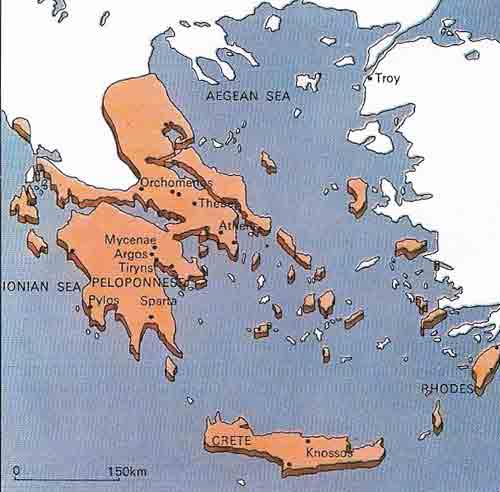
Figur 1. The Mycenaeans' homeland was the Peloponnese and adjacent parts of Greece, centered on the Argolid, and Mycenae itself. Here they built their distinctive version of the civilization already flourishing in Crete. As they took over the Minoans' sea trade, so their influence spread to the islands and coasts around the Aegean and beyond. This vast territory was never a unified state. More likely it was a collection of allied kingdoms.
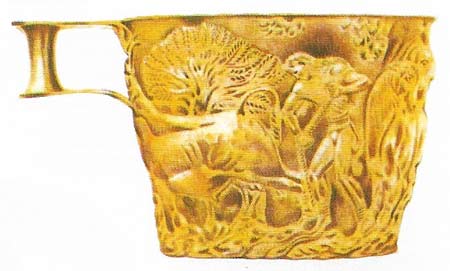
Figure 2. The Myceneans were strongly influenced by the Minoans. This gold cup from Vaphio, near Sparta, if not made in Crete itself must at least have been the work of a mainland craftsman trained in the Minoan tradition.
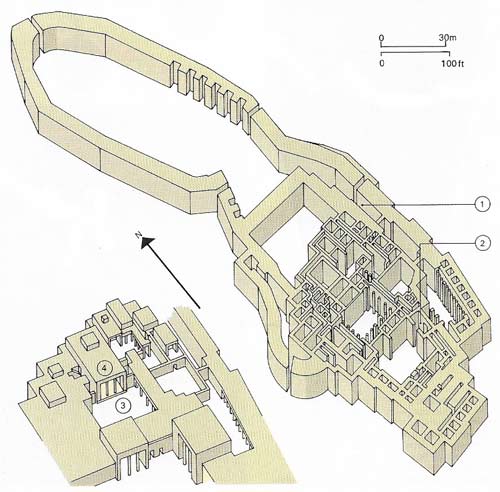
Figure 3. The fortified citadel of Tiryns, c. 1330 BC, typifies mainland architecture in the Bronze Age. A tortuous entrance passage (1) leads through the massive walls and an inner portico (2) leads to the first court. The administrative center took up the whole of the inner court (3) and the megaron (4), with its great central hearth, opening on to it. The main structural fabric consisted of a wooden framework and columns, and sun-dried bricks.
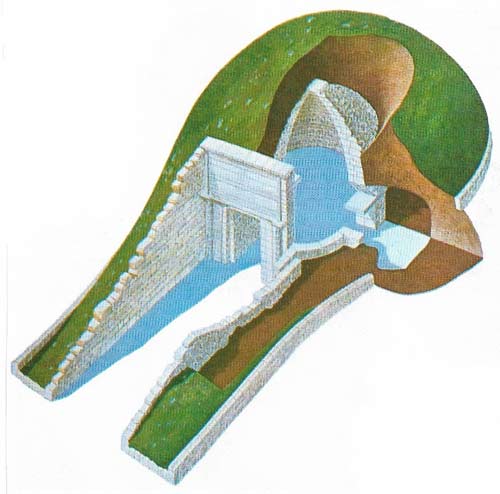
Figure 4. Earlier shaft graves were succeeded at Mycenae by stone-built tholos tombs. The finest is the so-called Treasury of Atreus c. 1320 BC. A walled passage leads to a tel door in the mound. Inside, a circular chamber is roofed by a corbelled vault. The bodies and grave goods were looted long ago, but other smaller tombs have also been found.
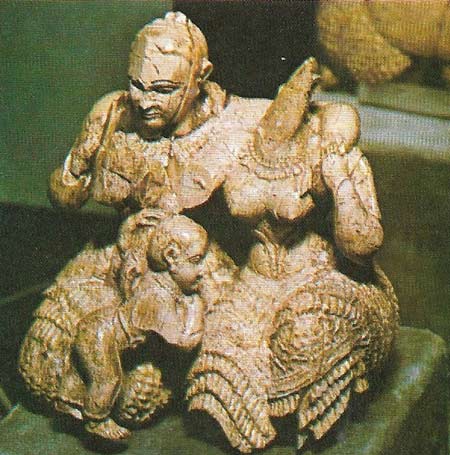
Figure 5. A delightful small find at Mycenae was this ivory carving only 6 cm (2.4 in) high, of two women and a child. Its function is unknown. Minoan influence is clear in both dress and carving.
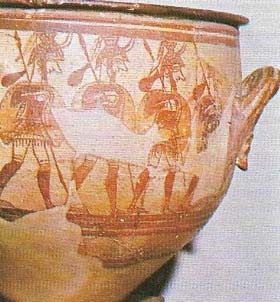
Figure 6. These Mycenaean warriors may have a comic flavor to our eyes, but the discovery of fortifications, weapons, and armor show that warfare was an important factor in life at that time.
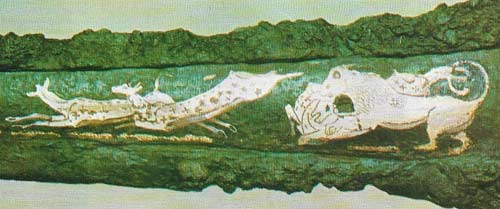
Figure 7. Bronze daggers from shaft graves of c. 1550 BC reveal great artistic skill in their gold, silver, and niello inlay. Some show sea creatures, one shows a hunting cat in Minoan style, but this one has a more robust mainland subject. A lion is attacking a deer while two more make their escape. The dagger is 23.5 centimeters (9.25 inches) long and one of the treasures discovered in Shaft Grave IV by Schliemann, the German archeologist.
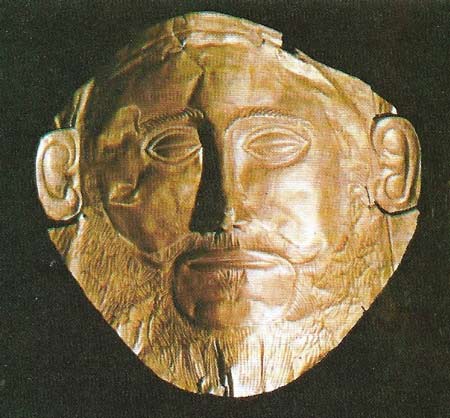
Figure 8. This gold mask shows a proud Mycenaean of c. 1550 BC. It was recovered from Shaft Grave V by Heinrich Schliemann in 1876.
Homer's Iliad and Odyssey, written between about 800 and 700 BC, record the exploits of legendary Greek heroes around the time of the Trojan Wars. For centuries the fact that this heroic age ever existed about 1800–1100 BC was in doubt, until Heinrich Schliemann (1822–1890), a German archeologist, recovered at Troy and Mycenae (from 1874) relics that supported the legends.
Bronze Age beginnings
This Greek Bronze Age, centered on the Greek mainland, began with the introduction of metal, important both for stimulating trade and for the acquisition of visible wealth. About this time, too, the grain economy of the plains of Thessaly and the north was replaced by one based on grain, olives and the vine, which flourished better in the south. By 2500 BC this economy supported a palace, the House of Tiles, at Lerna in the Plain of Argos. About 2200 BC however, Lerna and many contemporary settlements were destroyed by invaders from the northeast. These were probably the first inhabitants to speak a language recognizably Greek. At this time the fast potter's wheel and the megaron, a hall with pillared porch, were introduced. Soon after, their civilization showed signs of influence from their contemporary, Minoan Crete (Fig 2).
In time, however, strong towns grew up, such as Mycenae. The first real evidence of the flowering of the mainland civilization appears in the shaft graves of Mycenae itself, dating largely from the 16th century BC. They contain real solid wealth, in gold, silver and bronze, in crystal, alabaster and clay. We can assume that these were the resting places of a princely or even royal family, ruling a rich and integrated society. Many of the objects (Figures 5 and 7) reveal a contrast between polished and sophisticated craftsmanship, patently Cretan, and a very un-Cretan emphasis on weapons, armor and military scenes (Figure 6). The owner of the stern gold mask (Figure 8) was no soft courtier but a warring hero, an ancestor of those whom Homer portrayed.
These early Greeks also became seamen. A few of the objects from the shaft graves may be Egyptian work acquired through trade, rather than Cretan or Greek. Desirous of more trade goods from abroad and supported by local agricultural wealth, the Greeks began overseas ventures of their own, to Troy, to Palestine and Egypt, and to the Lipari Islands beyond the "toe" of Italy.
Expansion of Mycenaean civilization
But their opportunity came when the power of the Minoans was destroyed, perhaps by the cataclysmic eruption of Thera c. 1450 BC. This freed the rich trade routes of the Mediterranean which the Cretans had hitherto controlled. The mainlanders, comparatively untouched by the disaster, made the most of the new situation. Their pottery, valued both for its own sake and for the perfumed oil exported in it, rose sharply in price in both the Levant and Egypt: it was prized, for example, in Akhenaton's newly built Egyptian capital Tell el Amarna, about 1350 BC. Cypriot copper was carried in their ships. A great westwards trade port grew up at Taranto in southern Italy, bringing more copper from Sardinia and the eastern Alps, and amber from the distant Baltic. Crete itself was occupied by the Mycenaeans, and the Palace of Knossos was rebuilt as the seat of the new dynasty.
In the towns of Greece, craftsmen carried out their trades, producing fine metalwork, pottery and perishable goods. The towns themselves grew larger, stronger and better appointed. Walls were heightened and extended, with devices to ensure the safe supply of water. The palaces, still based on the traditional megaron plan, were now elaborately decorated with frescoes. The richly equipped tombs, now great corbelled tholoi (circular buildings first developed at this period) like the Treasury of Atreus (5), show the great architectural skill that had been attained by their builders.
To facilitate such a level of trade, craft and administration, writing was needed. The Minoans on Crete had developed a syllabic script of their own, still undeciphered. This is found inscribed on tablets and archaeologists have called it Linear A. The Mycenaeans adapted it, rather clumsily but adequately, for their Greek tongue (Linear B). In 1952 Michael Ventris, the English architect, deciphered Linear B and established beyond doubt that the Mycenaeans, Homer's Achaeans, were linguistically at least the true ancestors of the classical Greeks.
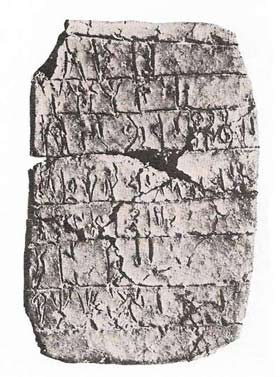 |
| The syllabic script came from Crete. Linear B script was extensively used for business documents, such as this stock list of herbs from Mycenae. The language used was an early form of Greek. |
Mainland civilization declines
The closing stages of Bronze Age Greece are difficult to understand. By one account hardy frontiersmen from the northwest, the Dorians, overran the cities of the south and sacked them all, except Athens. By another, the Mycenaeans lost their expansionist drive towards 1200, engaged in civil war – the siege of Troy exemplifies this – and in effect destroyed themselves. At around this time, there was certainly great unrest over a wide area, and the bands which unsuccessfully attacked Egypt in 1225 BC and again in 1191 BC included Aegean peoples.
In mainland Greece, the succeeding age knew little of what had gone before. Shabby villages replaced the flourishing towns, simple pits the great tombs, and common pots the masterpieces in clay, silver and gold. The one advance in this dismal period, sometimes referred to as the "dark age", was the introduction of iron-working.
